
Oda is a typical large room in an Albanian traditional house used by the host to receive and entertain the guests.

Oda is a typical large room in an Albanian traditional house used by the host to receive and entertain the guests.
Oda are used by the host to receive and entertain the guests. [1] [2] Traditionally, the host and the guests in the oda are old men and married men. Till the end of the 20th century, women and young boys were not allowed to enter the room. In the oda, the men talk, take political discussions and sing epic songs until late hours. During an oda "session", historical events and traditions are transmitted orally through discussions and songs. [3]
In the odas, knowledge were handed down the generations through epic tales and ballads. During 19th and 20th century—in order to counter the Turkish and Serbian bans on Albanian language—odas were secretly used for teachings in Albanian. In Yugoslavian Kosovo many odas were transformed into classrooms and home-schools to resume and conserve Albanian education. [4]
| Part of a series on |
| Albanians |
|---|
 |
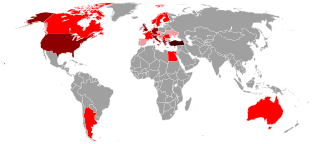
The Albanians are an ethnic group native to the Balkan Peninsula who share a common Albanian ancestry, culture, history and language. They are the main ethnic group of Albania and Kosovo, and they also live in the neighboring countries of North Macedonia, Montenegro, Greece, and Serbia, as well as in Italy, Croatia, Bulgaria, and Turkey. Albanians also constitute a large diaspora with several communities established across Europe and the other continents.
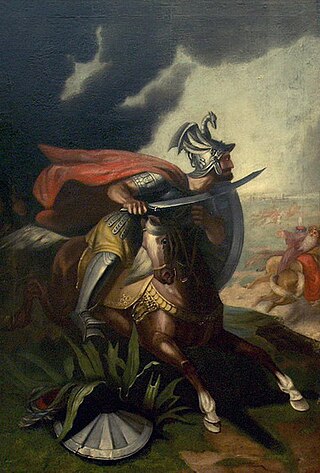
Miloš Obilić was a legendary Serbian knight who is reputed to have been in the service of Prince Lazar during the Ottoman invasion of Serbia in the late 14th century. He is not mentioned in contemporary sources, but features prominently in later accounts of the 1389 Battle of Kosovo as the assassin of Sultan Murad. The assassin remains anonymous in sources until the late 15th century, though the dissemination of the story of Murad's assassination in Florentine, Serbian, Ottoman and Greek sources suggests that versions of it circulated widely across the Balkans within half a century of the event.

Albanian culture or the culture of Albanians is a term that embodies the artistic, culinary, literary, musical, political and social elements that are representative of ethnic Albanians, which implies not just Albanians of the country of Albania but also Albanians of Kosovo, North Macedonia and Montenegro, where ethnic Albanians are a native population. Albanian culture has been considerably shaped by the geography and history of Albania, Kosovo, parts of Montenegro, parts of North Macedonia, and parts of Northern Greece, traditional homeland of Albanians. It grew from that of the Paleo-Balkan cultures, including Proto-Albanian, Illyrian, Thracian, Dacian, with their pagan beliefs and specific way of life in the wooded areas of far Southern Europe. Albanian culture has also been influenced by the Ancient Greeks, Romans, Byzantines and Ottomans.

The music of Albania is associated with the country of Albania and Albanian communities. Music has a long tradition in the country and is known for its regional diversity, from the Ghegs in the North to the Tosks in the South. It is an integral part of the national identity, strongly influenced by the country's long and turbulent history, which forced Albanians to protect their culture from their overlords by living in rural and remote mountains.
The gusle or lahuta is a bowed single-stringed musical instrument traditionally used in the Dinarides region of Southeastern Europe. The instrument is always accompanied by singing; musical folklore, specifically epic poetry. The gusle player holds the instrument vertically between his knees, with the left hand fingers on the string. The string is never pressed to the neck, giving a harmonic and unique sound.

A drawing room is a room in a house where visitors may be entertained, and an alternative name for a living room. The name is derived from the 16th-century terms withdrawing room and withdrawing chamber, which remained in use through the 17th century, and made their first written appearance in 1642. In a large 16th- to early 18th-century English house, a withdrawing room was a room to which the owner of the house, his wife, or a distinguished guest who was occupying one of the main apartments in the house could "withdraw" for more privacy. It was often off the great chamber and usually led to a formal, or "state" bedroom.
Music of Kosovo is music that originates from Kosovo, a country in the Balkans. Kosovo's population is mainly Kosovo Albanians, also known as Kosovars, and there are various minority ethnic groups as well. Kosovan music is closely related to that of neighbouring Albania, as well as to that of countries in the former Yugoslavia.
The name Kosovo is the most frequently used form in English when discussing the region in question. The Albanian spelling Kosova has lesser currency. The alternative spellings Cossovo and Kossovo were frequently used until the early 20th century.
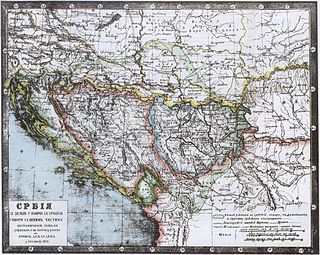
Old Serbia is a Serbian historiographical term that is used to describe the territory that according to the dominant school of Serbian historiography in the late 19th century formed the core of the Serbian Empire in 1346–71.

Albanian paganism comprises the pagan customs, beliefs, rituals, myths and legends of the Albanian people. The elements of Albanian mythology are of ancient Paleo-Balkanic origin and almost all of them are pagan. Ancient paganism persisted among Albanians, and especially within the inaccessible and deep interior – where Albanian folklore evolved over the centuries in a relatively isolated tribal culture and society – it has continued to persist, or at most it was partially transformed by the Christian, Muslim and Marxist beliefs that were either to be introduced by choice or imposed by force. Albanian traditions have been orally transmitted down the generations, well surviving into the 21st century in the mountainous regions of Albania, Kosovo, western North Macedonia, Montenegro and South Serbia and among the Arbëreshë in Italy, the Arvanites in Greece, and the Arbanasi in Croatia.
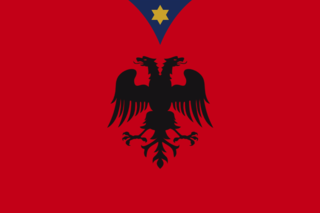
Albanian nationalism is a general grouping of nationalist ideas and concepts generated by ethnic Albanians that were first formed in the 19th century during the Albanian National Awakening. Albanian nationalism is also associated with similar concepts, such as Albanianism ("Shqiptaria") and Pan-Albanianism, that includes ideas on the creation of a geographically expanded Albanian state or a Greater Albania encompassing adjacent Balkan lands with substantial Albanian populations.
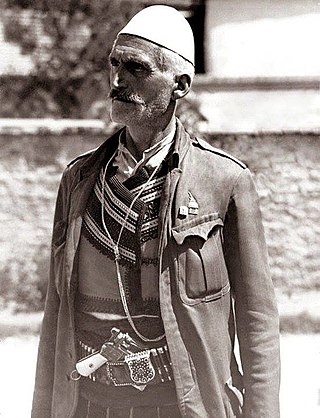
The Ghegs are one of two major ethnic subgroups of Albanians.

Rankovićism refers to a political ideology prevalent in the Socialist Federal Republic of Yugoslavia based on the political views of the Serbian communist official and former Yugoslav Partisan leader Aleksandar Ranković.

Albanian epic poetry is a form of epic poetry created by the Albanian people. It consists of a longstanding oral tradition still very much alive. A good number of Albanian epic singers can be found today in Kosovo and northern Albania, and some also in Montenegro. The Albanian traditional singing of epic verse from memory is one of the last survivors of its kind in modern Europe, and the last survivor of the Balkan traditions.
Albanian names are names that are used by Albanians in Albania, Kosovo, North Macedonia, Montenegro, or the diaspora. In Albania, a full name usually consists of a given name ; the given name of the individual's father, which is seldom included except in official documents; and a family name or surname. They are invariably given in the Western name order, with the given name being followed by the family name.
Monuments of Kosovo comprise all the monuments that are located in Kosovo.
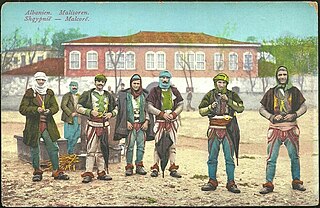
The Albanian tribes form a historical mode of social organization (farefisní) in Albania and the southwestern Balkans characterized by a common culture, often common patrilineal kinship ties and shared social ties. The fis stands at the center of Albanian organization based on kinship relations, a concept that can be found among southern Albanians also with the term farë.
In March and April 1981, a student protest in Pristina, the capital of the then Socialist Autonomous Province of Kosovo, led to widespread protests by Kosovo Albanians demanding more autonomy within the Socialist Federal Republic of Yugoslavia. The Presidency of Yugoslavia declared a state of emergency in Pristina and Kosovska Mitrovica, which led to rioting. The unrest was suppressed by a large police intervention that caused numerous casualties, and a period of political repression followed.
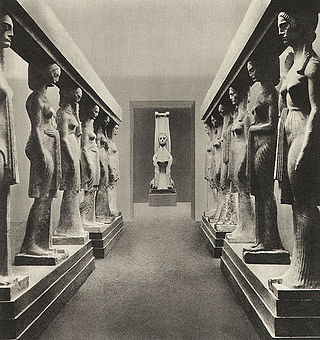
The Kosovo Myth, also known as the Kosovo Cult and the Kosovo Legend, is a Serbian national myth based on legends about events related to the Battle of Kosovo (1389). It has been a major subject in Serbian folklore and literary tradition and has been cultivated through oral epic poetry and guslar poems. The final form of the legend was not created immediately after the battle but evolved from different originators into various versions. In its modern form it emerged in 19th-century Serbia and served as an important constitutive element of the national identity of modern Serbia and its politics.
Kosovo is the birthplace of the Albanian nationalist movement which emerged as a response to the Eastern Crisis of 1878. In the immediate aftermath of the Russo-Ottoman war, the Congress of Berlin proposed partitioning Ottoman Albanian inhabited lands in the Balkans among neighbouring countries. The League of Prizren was formed by Albanians to resist those impositions. For Albanians those events have made Kosovo an important place regarding the emergence of Albanian nationalism. During the remainder of the late Ottoman period various disagreements between Albanian nationalists and the Ottoman Empire over socio-cultural rights culminated in two revolts within Kosovo and adjacent areas. The Balkan Wars (1912–13) ending with Ottoman defeat, Serbian and later Yugoslav sovereignty over the area generated an Albanian nationalism that has become distinct to Kosovo stressing Albanian language, culture, and identity within the context of secession from Serbia. Pan-Albanian sentiments are also present and historically have been achieved only once when part of Kosovo was united by Italian Axis forces to their protectorate of Albania during the Second World War.